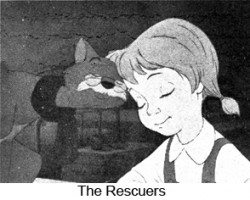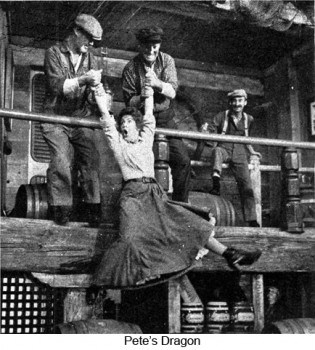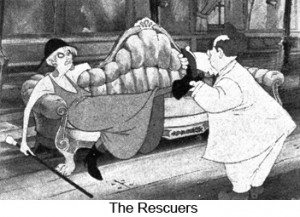Articles on Animation &Disney 14 Mar 2009 08:12 am
After Walt
- Didier Ghez on his site Disney History recently posted an article about life at the Disney Studio after Walt’s death in 1966. There were quite a few such articles during this period, and we were made to hope something would happen to generate life into the animation division of a company that was turning out bad films.
Time Magazine had the following article in their Aug. 16, 1979 issue:
CORPORATIONS
Running Disney Walt’s Way
When lung cancer killed Walt Elias Disney a decade ago, there were fears that the world of Disney would lose some of its wonder—and its profits. But before his own death in 1971, Roy Disney, who succeeded his younger brother, and a cadre of post-Walt executives had turned Walt Disney Productions into a thriving empire of fantasy. Today the company is bigger and richer than ever. Profits flow in from Disney’s two successful theme parks, Disneyland in California and the magic kingdom at Walt Disney World in Florida, from film rentals and television, from re-releases of such longtime favorites as Bambi, Pi-nocchio and Fantasia, and from sales of record albums, Mickey Mouse wrist-watches and everything else bearing the Disney stamp.
 Last year the various forms of escapism earned Disney nearly $62 million on sales of $520 million—four times the total in 1966 when Walt died. For the first nine months of its current fiscal year, Disney was flying higher than Dumbo the elephant. Corporate profits were up 30%, and sales rose 16%. More than 6 million people flocked to Disneyland (which turned 21 in July), another 9 million to Disney World. The fifth re-release of the animated Snow White and the Seven Dwarfs, which came out in 1937, will gross an estimated $10 million in the U.S. alone by the end of this year.
Last year the various forms of escapism earned Disney nearly $62 million on sales of $520 million—four times the total in 1966 when Walt died. For the first nine months of its current fiscal year, Disney was flying higher than Dumbo the elephant. Corporate profits were up 30%, and sales rose 16%. More than 6 million people flocked to Disneyland (which turned 21 in July), another 9 million to Disney World. The fifth re-release of the animated Snow White and the Seven Dwarfs, which came out in 1937, will gross an estimated $10 million in the U.S. alone by the end of this year.
Analysts’ View. No one questions that Disney has come a long way since the studio gambled $1.5 million on Snow White. But Wall Street analysts insist that the company should be doing even better and are hypersensitive to any developments that could remotely be considered adverse. Last month, for example, Disney stock fell several points (to around $50, or more than 20 times earnings) because third-quarter earnings, though a record $19 million, were not up to Wall Street’s expectations. Says a Disney vice president: “That’s a source of irritation around here. They seem to run in a pack on the Street.”
 The founder’s ideas still run the show: almost everything Disney is now into was conceived of by Walt. “That’s the way Walt would want it” is a refrain heard frequently in the stucco Disney headquarters in Burbank, Calif. The executive most responsible for sticking to Walt’s winning formulas is E. Car-don Walker, 60, who joined Walt as a camera operator in the 1930s and has been Disney president since 1971. A tall, husky man whose use of profanity is limited to an occasional G-rated “damn,” Card Walker occupies an unpretentious office on the Disney lot not far from Dopey Drive and Mickey Avenue. His only concessions to the Hollywood movie mogul image are tinted glasses and a sleek gray Porsche (license plate: CAR WIN).
The founder’s ideas still run the show: almost everything Disney is now into was conceived of by Walt. “That’s the way Walt would want it” is a refrain heard frequently in the stucco Disney headquarters in Burbank, Calif. The executive most responsible for sticking to Walt’s winning formulas is E. Car-don Walker, 60, who joined Walt as a camera operator in the 1930s and has been Disney president since 1971. A tall, husky man whose use of profanity is limited to an occasional G-rated “damn,” Card Walker occupies an unpretentious office on the Disney lot not far from Dopey Drive and Mickey Avenue. His only concessions to the Hollywood movie mogul image are tinted glasses and a sleek gray Porsche (license plate: CAR WIN).
Walker believes that “the biggest challenge we face is still to make top-quality films,” and film critics tend to agree. Though slick and successful, the recent crop of Disney animated and live-action films (Gus, Treasure of Mate-cumbe, Robin Hood) shows little of Walt’s skill at tugging an audience over pop-emotional peaks and valleys. Nor do the forthcoming The Rescuers and Pete’s Dragon. Indeed, not since Mary Poppins in 1964 has Disney produced a genuinely smashing, supercalifragilisti-cexpialidocious hit.
This fact troubles Walt’s corporate heirs. Says Walker: “I don’t know exactly what it is. We don’t cut costs. Based on the quality of people involved in the film making, I would just have to say that we do our best.” Others blame excessive reverence for the traditional Disney method of moviemaking: batteries of cartoonists working under a rigid discipline on a single project for as long as three years. Says one young artist-animator who worked briefly for Disney: “The work is too confining. There’s not enough room to use your creative talents. It’s sterile.”
More and more, Disney is setting its animators to work on gutsier movies that seize audiences instead of rocking them to sleep. One feature in the storyboard stage, The Hero from Otherwhere, is about two schoolboys who find themselves on a strange planet whose black leader persuades them to help destroy a wolf that has been ravaging the land. Another, Spacecraft One, about a mile-long spaceship in its search for life on other planets, is Disney’s most elaborate sci-fi undertaking since 20,000 Leagues Under the Sea. The Black Cauldron, still in the treatment-writing stages, is about a pig keeper’s struggle with a villain whose shtick is regenerating an army of warriors from dead bodies—a long way from Poppins. Sex and excessive violence still are taboo on the Disney lot, but Walker foresees increased sophistication as younger animators reflect contemporary themes.
 Non-film projects, however, account for three-fourths of Disney revenues and therefore generate the greatest excitement in the Disney organization. With Disneyland and Walt Disney World booming, the company is now moving on the biggest of Walt’s ideas: EPCOT, or Experimental Prototype Community of Tomorrow. To be built by the early 1980s in Florida as an expansion of Disney World, EPCOT will be a living laboratory of applied technology in transportation, housing, communications and waste disposal. Near it will rise the World Showcase, a permanent World’s Fair. Still another theme park. Oriental Disneyland, now planned to open late in 1979, will border Tokyo Bay in Japan; the Disney people expect it to draw 10 million visitors annually at the tourist hub of Asia. Estimated cost: about $175 million—most to be borne by the Japanese.
Non-film projects, however, account for three-fourths of Disney revenues and therefore generate the greatest excitement in the Disney organization. With Disneyland and Walt Disney World booming, the company is now moving on the biggest of Walt’s ideas: EPCOT, or Experimental Prototype Community of Tomorrow. To be built by the early 1980s in Florida as an expansion of Disney World, EPCOT will be a living laboratory of applied technology in transportation, housing, communications and waste disposal. Near it will rise the World Showcase, a permanent World’s Fair. Still another theme park. Oriental Disneyland, now planned to open late in 1979, will border Tokyo Bay in Japan; the Disney people expect it to draw 10 million visitors annually at the tourist hub of Asia. Estimated cost: about $175 million—most to be borne by the Japanese.
Double Duty. Whatever its problems, Disney has perfected one talent that other Hollywood fantasy factories envy: piggybacking. The familiar cartoon characters boost attendance at the theme parks, and the parks increase attendance at the movies. Though no one at Disney claims to be Walt’s equal in artistry or dreaming, Card Walker has made Disney’s characters do double duty as stars and as barkers to all the world. As a merchandising idea, it has proved to be almost as successful an inspiration as the original Mickey Mouse.

on 14 Mar 2009 at 12:02 pm 1.Tim Hodge said …
My, my, how things change. Just 5 years and a month after this article was printed, Michael Eisner was brought on board to save the company from the takeover. Mr. Walker’s big plans to lure teens into the theaters with films like “Tex” and “Tron” just didn’t pan out as expected*. “Splash” did pretty well, but I think that was too little, too late, since it came out in the summer of ’84. But not well enough to keep Card Walker and Ron Miller from losing their jobs.
(* The now defunct magazine “American Film” – published by the American Film Institute – had a cover story on these two offerings in 1982, and how Disney was polishing up it’s image for a new audience.)